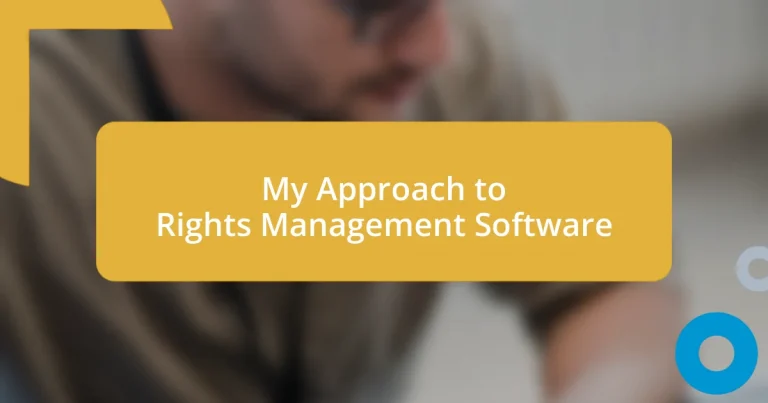Key takeaways:
- Rights Management Software (RMS) is crucial for tracking content ownership, protecting intellectual property, and streamlining licensing processes in the digital landscape.
- Implementing RMS enhances monetization opportunities, safeguards against copyright infringement, and improves collaboration among stakeholders through better communication and transparency.
- Common challenges in rights management include the complexity of contracts, inconsistent documentation practices, and the rapid evolution of digital technologies that can disrupt existing agreements.

Understanding Rights Management Software
Rights Management Software (RMS) is essential for managing, protecting, and monetizing digital content. I remember my first encounter with this software while working on a project involving multiple creators; it quickly became clear how vital it was to maintain control over various rights. Isn’t it fascinating how such software can navigate complex licensing agreements, ensuring everyone gets their fair share?
At its core, RMS enables organizations to track who holds the rights to what content, streamlining licensing and distribution processes. I’ve often been struck by how easy it is to lose track of rights, especially when many stakeholders are involved. Have you ever felt overwhelmed trying to juggle different contracts? That’s where RMS steps in, providing clarity and organization in an otherwise chaotic environment.
Moreover, the evolving landscape of digital content demands reliable solutions for rights management to combat unauthorized use and copyright infringement. I once saw a small independent artist face challenges losing revenue due to misuse of their work. With robust RMS tools, creators can regain control over their intellectual property, ensuring they can focus on their art instead of constantly worrying about who might be using it without permission. Isn’t it empowering to know there’s technology designed specifically to safeguard our creative endeavors?

Benefits of Implementing Rights Management
Implementing Rights Management Software offers significant benefits, particularly in facilitating the monetization of creative works. I recall a project where we struggled to monetize content due to vague licensing agreements. Once we integrated RMS, we could clearly define terms, leading to improved revenue streams. It genuinely felt like flipping a switch, illuminating previously hidden opportunities.
Another compelling advantage of RMS is the enhanced protection against infringement and misuse. I once worked alongside a colleague who had their music pirated; it was a stark reminder of how vulnerable creators can be without proper tools. The implementation of RMS not only helped us safeguard our content but also gave us peace of mind, knowing there was a system in place to track and report unauthorized use. It transformed our approach to content creation—from reactive to proactive.
Furthermore, RMS streamlines collaboration among multiple stakeholders, creating a healthier working environment. I remember participating in a collaborative project where communication about rights was often mismanaged. However, after adopting RMS, everyone involved had access to the same information, fostering a sense of trust. This clarity and transparency made our teamwork more effective and enjoyable, as we could focus our energy on being creative rather than untangling conflicts over rights.
| Benefits | Explanation |
|---|---|
| Monetization | Clear licensing agreements maximize revenue opportunities. |
| Infringement Protection | Robust tracking tools deter unauthorized use of content. |
| Streamlined Collaboration | Enhanced communication ensures trust and efficiency among stakeholders. |

Common Challenges in Rights Management
Navigating the landscape of rights management can often feel like walking through a maze. One of the most common challenges I’ve faced is the sheer complexity of multiple contracts. Have you ever tried to make sense of a dozen licensing agreements overlapping in time and scope? It can be a nightmare for anyone involved, and I’ve personally seen projects stall simply because no one could agree on who held the rights.
Another significant hurdle is the inconsistent documentation practices across different teams. In one instance, while organizing a large portfolio of work, I discovered numerous discrepancies in the documentation of rights held. This inconsistency not only slowed down our distribution efforts but also created confusion among collaborators. It made me wonder, how can we expect to manage rights effectively when records are scattered and incomplete?
Additionally, the rapid changes in digital technology often outpace our ability to adapt. I recall a time when a platform I was using changed its policies suddenly, which left me scrambling to understand how it affected our existing agreements. This unpredictability can lead to lost revenue and diminished control over content. Doesn’t it seem daunting when tools we rely on can shift beneath our feet, potentially jeopardizing our creative work and financial well-being?














